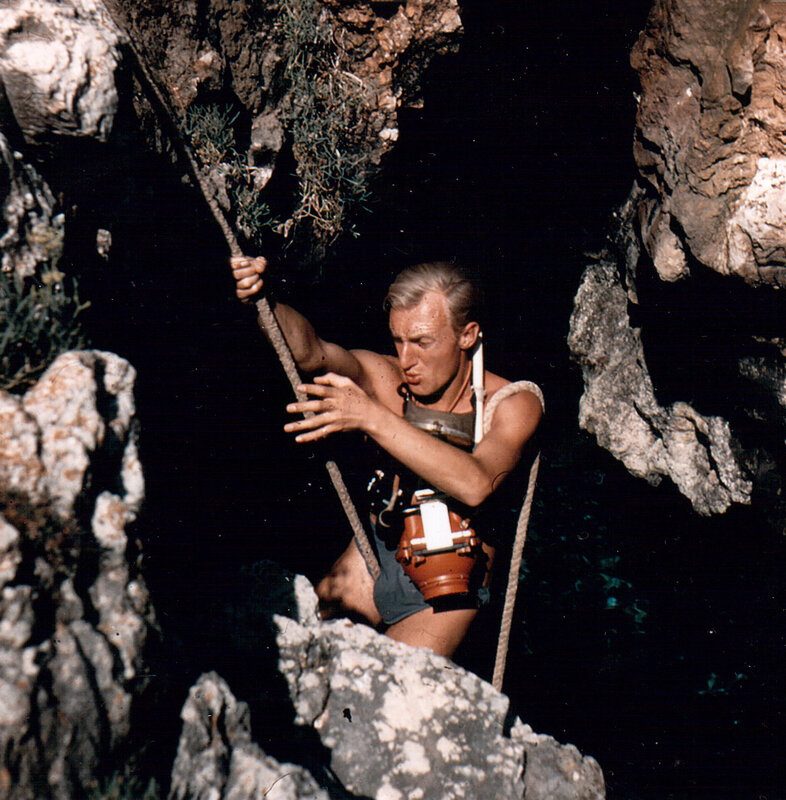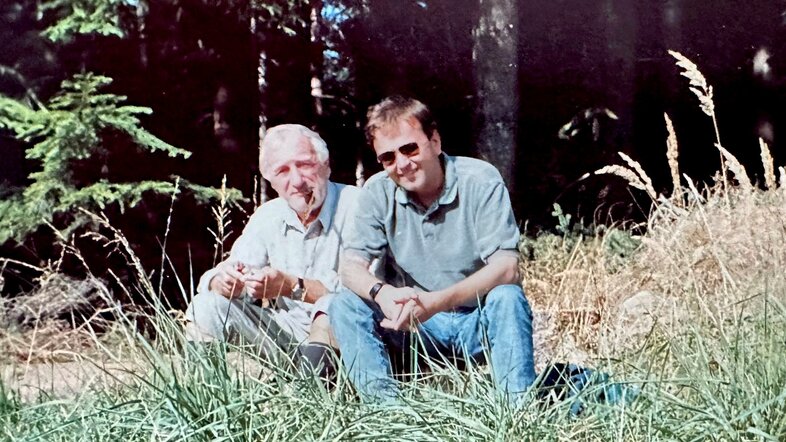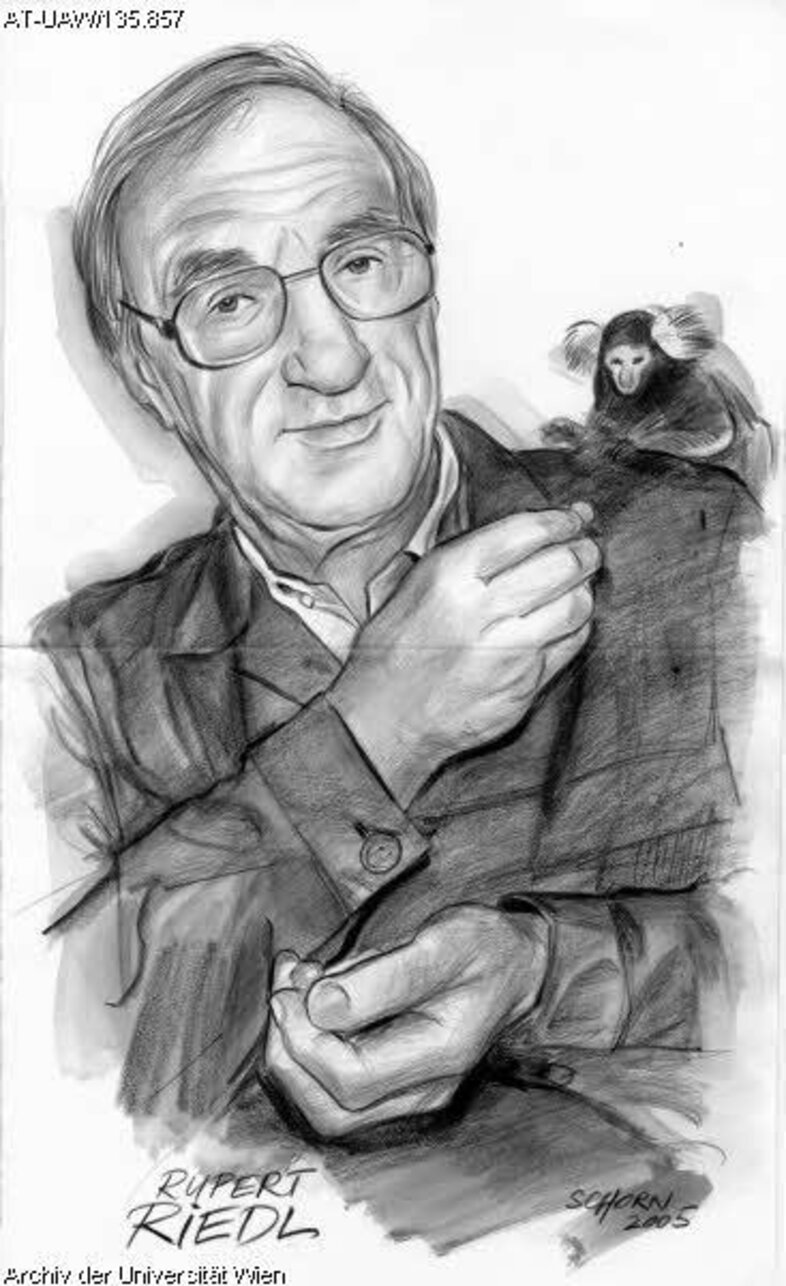The endless pursuit of life's hidden order
It starts with a question seemly unrelated to evolutionary biology. How did Austria, a landlocked country, become a world-renowned powerhouse for marine oceanography? In the late 1940s, a young, daring Austrian decided to explore the then-unknown underwater ecosystems of the Adriatic Sea. The catch: he had no background in marine biology and had never been to the sea.
"Rupert Riedl was a true adventurer," says marine biologist Jörg Ott. "He jumped right in with suicidal, self-made diving gear."
Daring to dive beneath the tides
Rigging surplus military equipment together from scratch, Rupert Riedl (1925 - 2005) began his risky deep dives around rocky shores and dark caves with a group of equally eager friends. As he finished his studies in zoology at the University of Vienna, Riedl started assembling the first systematic documentation of specimens across the Adriatic Sea – later expanded into a field guide for the entire Mediterranean – and captured rare footage of life beneath the tides. With these, he produced the first-ever underwater documentary in colour.
In 1971, after professorships at his alma mater and abroad, Riedl returned to the University to establish Austria's very first marine biology research unit.
Jörg Ott, one of Riedl's first PhD students, recalls how he gathered the courage to knock on Riedl's door after being smitten by the late professor's summer course in Croatia.
"I was so nervous," he recounts, "that when he asked me which marine animal group I wanted to work on, I mistakenly blurted out 'Nematoda', the roundworms ("Fadenwürmer" in German). But it was 'Nemertini', the colourful ribbon worms, that I wanted to study." The German word 'Faden' stands for 'thread', but the word 'fade' means boring – a reputation the bland roundworm notoriously held.
Riedl was delighted. With a hearty laugh – "nobody else wants to study them!" – Ott found himself committed to the 'boring worm,' which, thankfully, proved to be anything but at the end.
The now Emeritus Professor would later head the department of marine biology after Riedl at the University of Vienna.
The quest to understand the invisible order of life
Zoologist Rupert Riedl occupies a unique place in the University of Vienna's intellectual history. His tenure between 1971 – 1995 strongly shaped the University's research landscape in the life and cognitive sciences. Three departments, now hotspots for global talent, sprouted in his wake: marine biology, theoretical biology and cognitive biology. The range of his interdisciplinary impact is hard to imagine in today's research climate.
The common thread, based on interviews with his students, is an insatiable drive to better understand the invisible order lurking underneath surface observations, eventually examining how the mind itself has evolved to impose such order onto the world.
"He did something truly novel at the time," says Ott of his marine biology days. The flora and fauna Riedl identified and beautifully illustrated for his field guides were not listed as one dry fact after the other. There was a quiet logic to their organisation. "He teaches you to place things in the order of nature," Ott explains.
Riedl closely examined the similarities and variations of organismal form to try to place animals in their evolutionary order. Yet at the time, grouping organisms by their visible traits was dismissed by the mainstream as 'too subjective' and thus unscientific, according to Ott. This pushed Riedl to search for the foundational principles of biology that could make the comparison of animal form (comparative morphology) more rigorous.
And with that, Riedl handed marine biology over to Ott to fully turn his attention to theoretical biology.
Daring to push against the tide
The move from marine biology to theoretical biology brings to mind another famous naturalist and evolutionary biologist – Charles Darwin (1809 – 1882). Darwin is well-known as a revolutionary scientist who changed the world with his theory of evolution by natural selection. Before that, he also started as a marine natural historian, working for nearly a decade on the systematic classification of barnacles.
Similarly, the scientific method of classifying and analysing specimens revealed to Riedl a structured ordering established by evolution, explains biologist Gerd Müller. In his attempt to define the natural rules that generate this order, Riedl developed a systems theory of evolution that went further than the mainstream view of Darwinism at the time.
The now-Emeritus Professor met Riedl as a medical student. First drawn to lectures by Nobel Laureate Konrad Lorenz organised by Riedl, Müller caught his attention just in time for the final stages of Riedl's magnum opus, a book that espoused his evolutionary theoretical ideas – "Die Ordnung des Lebendigen" (Order in living systems) (1975) (English summary in the Quarterly Review of Biology, 1977).
Conversations in the office and the classroom marked a turning point for Müller's academic trajectory. Instead of preparing for his exams at medical school, he fell deep into the "bewildering world of theoretical evolutionary thought."
"Riedl rebelled against the dominant view of evolution," states Müller, who later followed Riedl's footsteps as chair of theoretical biology. The mainstream position, often called 'neo-Darwinism,' assumed that natural selection independently tinkers with every minute feature of organisms, building up change bit by bit until eventually, a major evolutionary transition is instigated. Examples included the gradual evolution of land animals from early fish or the appearance of mammals.
Yet neo-Darwinism doesn't explain how, for instance, the incredible diversity of life only makes use of a few basic body plans (e.g., the segmented insects, the serially organized vertebrates, the radial symmetry of jellyfish) or how novel traits originate. Riedl proposed that evolutionary innovations that came later in time could've anchored onto the structures of earlier parts in order to properly develop and function.
According to Müller, these earlier parts will be so heavily 'burdened' by genetic, developmental, and functional interdependencies that they become 'too integrated to fail,' so to say. "The patterns of integration collectively come to influence the course of organismal change. These insights led Riedl to conceive a systems theory of evolution that replaced linear causation with feedback causation."
Without a firm rooting in natural history, he would not have achieved his theoretical insights.Gerd Müller
Müller built on Riedl's work to push forth the emerging field of 'evolutionary developmental biology' (evo-devo), which complements Darwinian thought by incorporating developmental processes and principles into evolutionary theory.
Theoretical biology under the influence of Riedl
A common misconception, says theoretical biologist Mihaela Pavlicev, is to think of theorising in biology as merely running computer simulations or building mathematical models. "But no, we don't just sit behind computers all day." The professor is currently leading the Unit of Theoretical Biology at the University of Vienna. The unit's experimental projects bring together morphology, physiology and development with evolutionary genetics.
"Theoretical biology is focused on the concepts that interpret data," says Pavlicev, who was once a student in Riedl's lectures. She is organizing the 100 year anniversary symposium on Riedl's legacy in theoretical biology at the University.
In the era of big data, theory is more important than ever. "Students today are starving for concepts," she exclaims, talking about the excitement in her systems biology class.
Reflecting on Rupert Riedl's legacy in theoretical biology
In November 2025, the University of Vienna will reflect on Riedl's ideas in theoretical biology. The 65th phylogenetic symposium: "100 years of Rupert Riedl: Systems conditions for evolution," will take place between Nov 21-23rd 2025, at the University Biology Building. It is co-organised by Mihaela Pavlicev (University of Vienna), Frank Zachos (Natural History Museum Vienna), Manfred Drack (University of Tübingen) and Günter Wagner (Yale University/University of Vienna).
The Club of Vienna, the Haus des Meeres, the Natural History Museum of Vienna and the KLI also celebrated his anniversary this year.
When the ability to evolve also evolves
One such concept is 'evolvability,' a trait's ability to evolve, which Riedl reflected on in his idea of evolutionary 'burden.' Observations show that some features have the flexibility and room to evolve in multiple directions, while others are stuck in a rut with limited options. "In the long term," states Pavlicev, "this leads to shared structures, recognised as 'homologies,' such as those between our arms and the forelegs of horses." These properties of evolvability can be experimentally examined by analysing how developmental processes and morphological structures affect evolution.
A trait's ability to evolve can itself evolve, that is, a trait can evolve to become more or less evolvable. This dazzling idea seems quite abstract but is also experimentally approachable. "Riedl helped us realize that the way genetic materials can change through time could itself be controlled by other genes," states Günter Wagner, one of the earliest doctoral students of Riedl. Wagner started his work in Riedl's electron microscope lab, which was also the first of its kind at the University of Vienna.
"Evolvability is an actively developing area of research that is far from settled." The Emeritus Professor at Yale University took the ideas of evolvability and homology to heart from his time with his mentor. "Some questions are so big, it takes more than a lifetime to answer. So many of Riedl's ideas are transportable and can be solved as science continues to develop more tools," says Wagner, now teaching and conducting research at the theoretical biology unit.
Some questions are so big, it takes more than a lifetime to answer.Günter Wagner
Daring to go beyond the tide
"Can fish count?" One day, Rupert Riedl sprung this question on an unsuspecting Ludwig Huber, then a student of Riedl. "Lorenz thinks they can count, so let's test this idea."
Under Riedl's supervision, the cognitive biologist conducted the first empirical studies on the cognitive features of animals at the University of Vienna, probing the pattern recognition and rational capacities of marmosets, fish, then pigeons.
By then, Riedl had started to tackle the scientific and philosophical question of how we can study how humans, as animals, have evolved to understand the world by imposing our sense of order on it. He thus created yet another field of research on the evolutionary origins of cognitive understanding and knowledge called 'evolutionary epistemology.'
"The most important take-home message," says the professor, "is that the human mind is also a product of evolution." Huber, now professor at the University of Veterinary Medicine, was Riedl's final research assistant at the University of Vienna. He went on to co-found the Department of Cognitive Biology at the University of Vienna in 2010.
He "rebelled against the view that the study of cognition was the exclusive domain of philosophers and psychologists," wrote Müller, adding that Riedl's interest in the human mind was also motivated by the desire to better understand how humans theorise scientifically about the world.
His ideas were big, but he never tells you exactly what to do. His only demand is high scientific quality.Jörg Ott
Big ideas start with rolled-up, dirty sleeves
It seems clear that we cannot use the standards of our time to track Riedl's legacy. "He is now rarely cited and his name only occasionally mentioned," stated Huber wistfully. Several factors may explain why. According to his former students, his work, primarily published in German and often in book form, was not easily accessible to the international community. The 'maverick' tendency to bulk against the mainstream may have had an influence on his visibility as well.
Yet the fruitfulness and influence of his research comes from his ability to combine theoretical abstractions with the rigor of his experiments, the way he brought interdisciplinary forces together, and his habit of empowering students to pursuit their own questions.
"If you have a question regarding life in submarine caves, you invent your own diving equipment and go underwater. Or you have a question about how organisms adapted to life at sandy seashores, go dig up buckets of slimy mud and analyse its content. If you want to know how minute structures can help in classifying worms, get one of the first electron microscopes. You have questions regarding the evolution of the human mind? Set up cognition experiments with octopuses and marmosets." Müller was most inspired by Riedl's hands-on attitude towards solving scientific questions. He is currently the Honorary President of the Konrad Lorenz Institute for Evolution and Cognition Research (KLI), an institute founded by his mentor.
"Nothing comes from thin air. He theorised, but he also did excellent work in the lab," says Pavlicev. Wagner agrees. "He was not the type of theorist decoupled from reality." To be creative in science, he continues, "we need an intuition, a feel of the field you're studying. And this was developed in Riedl by being a naturalist, by being intimately familiar with anatomy, doing all the animal work himself, including cleaning the cages." "He would always bring his theoretical questions to the test," says Huber.
Seeing how Riedl's spirit and style of research lives on through the research programmes set up by his academic descendents at the University, perhaps there is more than one way to judge the legacy of a scientist.
The author would like to thank Sabina Riedl as well as the University Archives for granting the magazine permission to use Riedl's images and photos.
Rupert Riedl received his doctorate from the University of Vienna in the field of zoology in 1951. He completed his habilitation in 1960. In 1971, he returned to the University of Vienna and created research units in marine biology, electron microscopy and theoretical biology. After his retirement in 1995, he continued to hold lectures at the University. Riedl passed away on September 18th, 2005 in Vienna.










